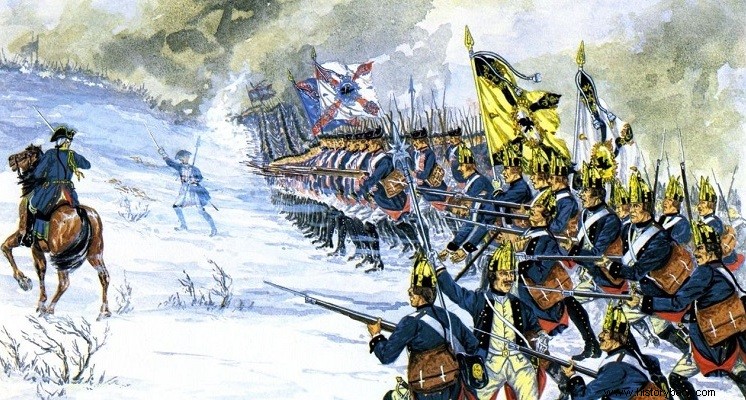
After the end of the Thirty Years' War (1618-1648), the small electorate of Brandenburg was completely destroyed. His army numbered only a few thousand men. It took a great deal of effort from Elector Frederick William to reorganize the state and the army. 1675 was a landmark year for the historical course of Prussia or Duchy of Brandenburg, as it was then known .
The reborn army of the small state, under the worthy leadership of Marshal Derflinger , crashed in Farbelin of Pomerania, the previously undefeated Swedish Army. All Europe was astonished, and Prussia began to acquire the status of a great power.
In 1689, a new war broke out on the Old Continent, the War of the Great Alliance (1688-1697), in which the Prussian Army participated, as an ally of the Austrians and the English. Under the command of Prince Leopold of Analt Dessau , the Prussian Army fought brilliantly alongside the Austrians and the British again, in the War of the Spanish Succession (1701-1713).
In the battles of Blenheim (1704) and Maplake (1709) in particular, the Prussian infantry created with their blood a legend, that of the "iron", invincible infantry. As a reward for their services, the Austrian emperor upgraded the duchy of Prussia to a kingdom.
From 1713 to 1740 the Prussian Army was not involved in any conflict. During this period, however, the foundations of its development were laid. The Prince of Analt Dessau, one of the best "infantrymen" in military history, undertook, even in peacetime, with zeal, the task of maintaining and developing the fighting value of the infantry. The prince considered as the primary virtue of the foot soldier the demonstration of blind obedience to his superiors.
In battle the men had to behave like automatic machines. Each soldier was just a cog in the machine. The continuous training and the holding of large high schools twice a year - a pioneering concept for the time – gradually brought the desired result. Two other factors helped to strengthen the Prussian infantry. The first concerned the introduction of synchronized stepping - what today we simply call step - around 1730, by Prince Leopold.
Synchronized step had disappeared from European armies for centuries. Without its use the movement of units, especially in line formation, was extremely slow. Every now and then the section had to stop and line up. With the use of synchronized pacing, however, the data changed. Prussian infantry became capable of moving in line formation at the astonishing rate of 75 paces per minute, while the infantry divisions of other European armies rarely approached the rate of 50 paces per minute.
The speed of the Prussian infantry gave it a serious tactical advantage and later allowed Frederick, exploiting this very advantage, to apply the tactic of the slanted phalanx . The second factor that also gave the Prussian infantry a tactical advantage was their provision of iron musket loading bars, as opposed to the wooden ones used by their opponents. With the use of the iron rod the rate of fire increased dramatically.
Of course, this was helped by the use of the British-Dutch execution and fire control system, which the Prussian infantry had been using since 1704. The specific system (platoon firing) it allowed the infantry leader to launch powerful volleys against the enemy front, always keeping 1/3 of the battalion's men as "reserve" fire.
In this way at any time the battalion was able to dispose of a considerable number of men while the others were aiming or filling. The Prussian infantry was able to charge at rates unimaginable for the time. The usual rate of fire, in battle conditions, was of the order of 4 rounds per minute, twice that of all other European armies. If necessary, the rate could be increased to 7 shots per minute! On average, a Prussian battalion of 600 men was capable of putting in about 2,500 cartridges in one minute!
However, the limited effectiveness of the musket did not help to achieve a substantial effect except at a very short distance from the enemy. Although theoretically the useful range of the musket reached 400 meters it was extremely unlikely to achieve a hit, even with a aimed shot, at a distance of more than 200 meters.
Usually volleys between opposing infantry units were fired from a distance of 300 paces (200 meters). Again, however, the small projectile velocity of the musket (about 150 meters per second), did not ensure the achievement of a blow capable of killing or even seriously injuring the opponent.
At the battle of Csotuzic, for example, the victorious Prussian infantry fired a total of 650,000 rounds, causing the Austrians only 5,000 casualties. Although inadequate beyond 100m, the musket was capable of shredding enemy lines at distances below 100m. Only the highly trained footmen, however, had the composure to approach the enemy so close, being the first to receive his murderous assault.
When Frederick assumed the rule of the kingdom of Prussia, the infantry consisted of 31 regiments of musketeers. It still had the Grenadier Regiment of the Guard, the famous 'Giant Regiment' , which the new king's father had set up. Each of the 3,000 grenadiers of this regiment had to be over 1.80 meters tall. The constitution was more ceremonial and less practical. That's why Frederick broke it up.
By 1740 there were two types of line infantry, the elite grenadiers and the musketeers – the common riflemen. In 1740, with the start of the warFrederick formed new regiments of fusiliers. The fusiliers they took their name from the fuzil, a lighter type of musket, with which they were equipped. Their essential difference from their musketeer colleagues, however, was the different, mitre-type hat they wore, compared to the classic tricot of the musketeers.
Between 1740 and 1758, Frederick formed 18 regiments of fusiliers. In 1773-74 another regiment of musketeers and 5 fusiliers was formed. All footmen carried much the same armament, a musket or fuzil, a short sword and long bayonet. The officers and non-commissioned officers were armed with swords and short weapons, something between a spear and a lance, called a spontoon.
Organization
The basic combat unit of the infantry was the regiment. Each Prussian infantry regiment, whether musketeers or fusiliers, had 2 battalions. Exceptions were the 15th Musketeer Regiment of the Guard and the 3rd Musketeer Regiment of Prince Anald Dessau and the 6th Guards Grenadier Regiment. The first two had 3 battalions and the third only one, but a reinforced battalion. Each battalion had 5 companies of musketeers or fusiliers and 1 company of elite grenadiers.
The strength of the company was 120 fighting men. The grenadier companies were usually detached from the battalions and joined together to form independent elite grenadier battalions. Each grenadier battalion consisted of 4 companies and its numerical strength did not exceed 500 men. Grenadier battalions were named after the numbers of the regiments to which their companies belonged.
Every infantry regiment, with the exception of those of the Guard, belonged to a noble-senior officer, usually. The "owner" of the regiment was responsible to the king for the training of the men and for meeting every need, in terms of equipping and supplying the regiment, which bore his name in his honor. The costs of maintaining the constitution burdened, in part, both the owner-honorary commander and the state budget.
Honorary commander of the 15th Regiment of Guards was King Frederick himself, who had undertaken this duty since 1731, 9 years before he became king. Practically every regiment was commanded by a colonel or lieutenant colonel, who in the majority of cases had nothing to do with the honorary commander. But this in no way meant that the respective honorary commander did not have a close relationship with his regiment.
Field Marshal Schwerin, for example, honorary commander of the 24th Musketeer Regiment, personally led his regiment, flag in hand, into the Battle of Prague (1757) and was killed at the head of his men.
The total strength of a regiment of the two battalions exceeded 1,800 men. This number included the grenadiers, the musicians, the craftsmen, the medical and nursing staff and the staff of the regiment.
The "iron" line regiments of the Prussian Army
During the Seven Years' War, the Prussian Army fielded 49 line infantry regiments of each type (musketeers and fusiliers). The numbering of the constitutions was derived from the order of their seniority. Some of them had been formed and joined service in other armies. Thus, their order of seniority was determined by the date of their joining the Prussian Army.
Of the soldiers that made up the infantry regiments, at least 1/3 were foreigners, coming mainly from the small German states neighboring Prussia. But there were others who came from France, Switzerland, Ireland, Italy, and even from the Ottoman Empire . Most foreigners served in the younger regiments of fusiliers, and there were almost entire regiments that had only mercenaries. Even the highest officers of the Prussian Army were foreigners.
Naturally, the connecting link of this motley military machine was none other than harsh discipline. According to Frederick, men should fear their officers more than the enemy.
There are many examples of blind devotion, to the point of death in duty and especially in Frederick himself. In the battle of Mollwitz (1741) there was a French mercenary who, with self-sacrifice, saved Frederick's life. It was the Irishmen of the 19th Regiment who sacrificed up to one at the Battle of Hokirk (1758), to allow their colleagues to withdraw, after the surprise attack of the Austrians. The 2/19th Battalion stubbornly defended the village church and when they ran out of ammunition charged the enemy with their lance!
Only discipline and a strong spirit of unity formed the connecting link of the army. The strength of a disciplined infantry division of the time did not consist in individual action, but in its ability to act collectively, summing up the efforts of the men who made it up.
At this point it is worth making a brief mention of the most famous Prussian infantry regiments and their action.
The 1st Regiment of Musketeers was the oldest unit of the Prussian Army. It had been founded in 1615, shortly before the start of the Thirty Years' War. During Frederick's reign, the regiment fought in the Silesian Wars (1740-45). With the outbreak of the Seven Years' War (1756-63) the regiment fought in the bloody victorious Battle of Prague (1757), the famous Battle of Rosbach (1757), Luten (1757), the disastrous for the Prussian arms the Battle of Hokirch (1758 ), in Liegnitz (1760), Torgau (1760) and Bukersdorf (1762).
Another famous infantry regiment was the 3rd Musketeer Regiment of Analt Dessau . The regiment was formed in 1655. It took part in many battles. In the battle of Dresden (1760) the regiment fled. As punishment Frederick ordered the dishonorable removal of the swords from the men. Three weeks later, on August 15, 1760, at Liegnitz, his men, determined to regain their lost honor, single-handedly charged the Austrian cavalry and put it to flight with the lance.
After this, Frederick himself congratulated the men of the 3rd and ordered their swords to be restored to them. "All is forgotten and all is forgiven, except this day," he declared to his men, who cheered gathered around him.
Also famous was the "heavyweight" 13th Regiment of Musketeers, the famous "lightning and thunder" regiment , whose four honorary commanders were killed between 1740 and 1762. Three of them were Prussian nobles who fell in battle. The fourth was Tsar Peter III of Russia, who was assassinated by the Orlov brothers and his wife Catherine the Great . Despite the misfortune of its honorary commanders, however, the fighting behavior of the regiment was not affected. The regiment particularly distinguished itself at the Battle of Prague (1757), led by the king's brother Prince Henry. The constitution was established in 1686.
The 15th Musketeer Regiment of the Guard it was founded in 1688. From 1731 its honorary commander was Frederick himself. His 1/15th Battalion particularly distinguished themselves at the Battle of Molwich. Of his 800 men only 180 were still standing when the battle ended. The 2/15th and 3/15th Battalions distinguished themselves in every battle in which they took part and particularly in that of Rosbach. The 17th, 18th, 19th, 23rd and 24th Musketeer Regiments also belonged to the distinguished units of the Prussian infantry. The latter even had the honor of being led into the battle of Prague by its own honorary commander, the brave field marshal Kurt von Schwerin .
The marshal, frustrated by the inability of the Prussians to break through the Austrian positions, seized the flag of the 24th and on horseback rode it forward, only to fall dead from the enemy's fire. But his men avenged his death, attacked and finally won. Of the fusilier regiments, the 35th and 49th stood out. The latter had been joined by men of the Engineer's gun. For this regiment was known as the Pioneer Regiment. Despite its "humble" origins and its "young age" - founded in 1758 - the regiment fought exceptionally well in the battles of Chondorf (1758) and Torgau (1760).
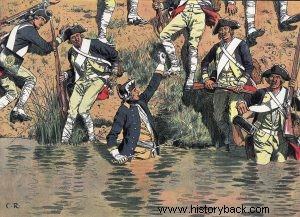
The king's brother, Prince Henry of Prussia leads his men at the Battle of Prague (1757).
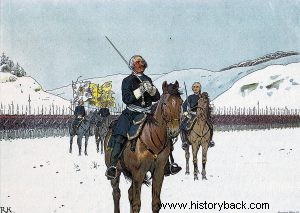
Prince of Anaalt Dessau prays before the Battle of Kesseldorf.
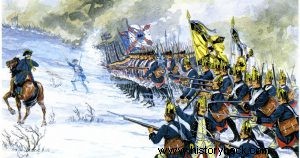
The 18th Musketeer Regiment and the 46th Fusilier Regiment at the Battle of Kesseldorf.
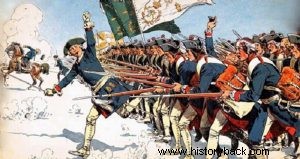
The Prussian infantry at the Battle of Mollwitz.
